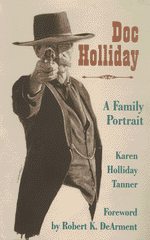
You Won't Get Any Snake Oil In Karen Tanner's Tome On The Life Of Doc Holliday.
By Emil Franzi
Doc Holliday: A Family Portrait, by Karen Holliday Tanner
(University of Oklahoma Press). Cloth, $28.95.
THERE'VE BEEN several recent biographies of legendary characters
in Western and Arizona history that purport to be "definitive."
Doc Holliday: A Family Portrait truly seems to live up
to the claim.
 Karen Holliday Tanner is the great-granddaughter of Doc Holliday's
uncle. The Holliday family has preserved not only their own history,
but that of the man who may have been their only black sheep.
Tanner--along with husband John, a history professor who aided
her in writing the book--either possessed or had access to many
previously unpublished materials, kept intact through the years
by family members.
Karen Holliday Tanner is the great-granddaughter of Doc Holliday's
uncle. The Holliday family has preserved not only their own history,
but that of the man who may have been their only black sheep.
Tanner--along with husband John, a history professor who aided
her in writing the book--either possessed or had access to many
previously unpublished materials, kept intact through the years
by family members.
The Hollidays were a prominent Georgia family for generations,
and were related to Margaret Mitchell. Tanner even points out
certain similarities between family members and characters in
Gone With the Wind. She offers a wealth of information
on the Doc's early life, never before presented to this reviewer's
knowledge.
There was little in Doc's growing years that would have stamped
him as the historic figure he became, other than a penchant for
gambling common to his Georgia culture. He planned to be a dentist,
and graduated from the Pennsylvania College of Dental Surgery.
The thoroughness of Tanner's research on her distant cousin is
exemplified by her discovery of a dentist named Dr. Allison, currently
practicing, who in 1961 had an elderly patient who had been a
patient of Holliday's when she was a child--and Tanner bothers
to find the records to prove it.
Doc left Georgia for Texas at age 22, in search of a better climate
for his tuberculosis. He began spending more time in that era's
ever-present gambling halls than he did at his dental office,
although he was always able to make a living as a dentist when
he wanted to. From Texas he moved about the West, making the acquaintance
of friends like Bat Masterson and Wyatt Earp. He did a lousy job
of taking care of himself, and died in Colorado at age 36.
Holliday would no doubt be shocked to know he's since become
a legend. The movies had one part right--he was a southern gentleman
and a classy dresser. But he wasn't the cold-blooded killer he's
often been portrayed as.
 Earp, his good friend, was. That Doc was along for some of the
rides is clear--maybe even a few more than credited elsewhere.
But Tanner can find no hard evidence that her distant cousin ever
killed anybody outside of that fabled day in Tombstone. Apparently
he tried a couple of times, but there's no proof of any other
successes.
Earp, his good friend, was. That Doc was along for some of the
rides is clear--maybe even a few more than credited elsewhere.
But Tanner can find no hard evidence that her distant cousin ever
killed anybody outside of that fabled day in Tombstone. Apparently
he tried a couple of times, but there's no proof of any other
successes.
Tanner has meticulously gone through public records in numerous
states as well as a variety of contemporary newspaper sources,
and she lists a massive bibliography of secondary sources. She
makes a host of corrections in some of the latter. In her quiet
and meticulous style, she lays to rest myth after myth, and deflates
a much of the hype surrounding one of the West's most recognizable,
if discredited, personalities.
The deed will unlikely go unpunished by some of the Earpomania
types, but the case she presents in a mere 232 pages, with another
hundred of notes and bibliographies, seems ample back-up to her
claims. That this book was published by the University of Oklahoma
Press, which has been a bastion of Western history for years,
and that the foreword is by the distinguished Western historian
Robert K. De Arment, further bolsters its credibility.
In a sea of hopefuls, this could finally be the definitive book
on Doc Holliday. As such, it's also one of the most important
volumes of Western history to be published in some time. And with
its simple, direct, unhyped language, it's a good read to boot.
Even if some of her contemporaries snort, real historians will
commend Tanner for years to come.

|





